- 1State Key Laboratory of Precision Spectroscopy, East China Normal University, Shanghai, China
- 2NYU-ECNU Joint Institute of Physics, New York University at Shanghai, Shanghai, China
We propose a scheme to realize the storage and retrieval of optical Peregrine solitons in a coherent atomic gas via electromagnetically induced transparency (EIT). We show that optical Peregrine solitons with very small propagation loss, ultraslow motional velocity, and extremely low generation power can be created in the system via EIT. We also show that such solitons can be stored, retrieved, split, and routed with high efficiency and fidelity through the manipulation of control laser fields. The results reported here are useful for the active control of optical Peregrine solitons and promising for applications in optical information processing and transmission.
1 Introduction
Rogue waves, first observed in ocean surfaces, are highly isolated spatial-temporal wave packets with very large amplitudes when some special conditions are attained [1]. Such waves are ubiquitous in nature and quite intriguing, since they “appear from nowhere and disappear without a trace” and have extremely destructive power [2]. Except for ocean waves, the study on rogue waves has been extended to many other different physical contexts, including atmosphere [3], superfluid helium [4], capillary waves [5], water waves [6], photorefractive ferroelectrics [7], plasmas [8], ferromagnetic materials [9], and so on [10, 11].
Peregrine soliton, firstly suggested by D. H. Peregrine in the early 1980s for nonlinear dynamics of deep waters [12], is commonly taken as a prototype of rogue waves [13, 14]. Such soliton, i.e., localized rational solution of nonlinear Schrödinger equation, can be taken as a limiting case of the one-parameter family of Kuznetsov–Ma breathers [15] or Akhmediev breathers [16]. There have been considerable interests on Peregrine solitons occurring in a variety of physical systems [17–39]. Many efforts have also been devoted to the new understanding of Peregrine solitons through the analysis of other types of nonlinear partial differential equations [40–51].
Among various rogue waves, optical rogue waves have received much attention due to their interesting properties and promising applications [10, 11, 25–39, 52–54]. However, the creation of the optical rogue waves is not an easy task in conventional optical media (such as optical fibers and waveguides). The reason is that the nonlinear optical effect in such media is very weak, and hence a large input optical power is needed to obtain a significant optical nonlinearity required for the formation of rogue waves. Although some resonance mechanisms may be exploited to enhance nonlinear effects, near resonances significant optical absorptions occur, which result in serious attenuation and distortion of optical pulses during propagation.
In recent years, many efforts have been focused on the investigation of electromagnetically induced transparency (EIT), a typical quantum interference effect occurring in three-level atomic systems, by which the light absorption due to resonance may be largely suppressed and giant Kerr nonlinearity may be obtained simultaneously [55]. By means of EIT, it has been shown that weak-light solitons and their storage and retrieval can be realized [56–58]. Recent works [59, 60] have demonstrated that it is possible to generate optical Peregrine solitons with low generation power in EIT-base atomic systems.
In this work, we suggest a scheme to realize the memory of optical Peregrine solitons in a
The article is arranged as follows. In Section 2, the physical model and ultraslow weak-light Peregrine solitons and their propagation are described. In Section 3, the storage, retrieval, splitting, and routing of such solitons are presented. Finally, Section 4 gives a summary of the main results obtained in this work.
2 Model and Ultraslow Weak-Light Peregrine Solitons
2.1 Model
We start to consider a cold three-state atomic gas with
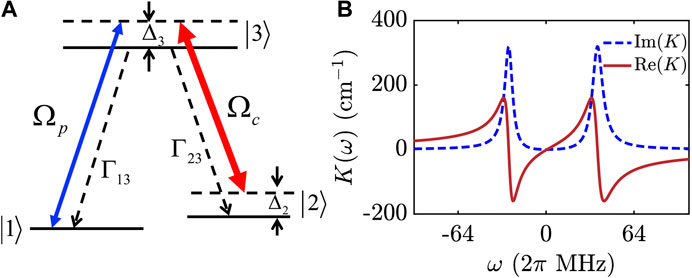
FIGURE 1. (A) Energy-level diagram and excitation scheme of the
The total electric field in the system reads
The Hamiltonian of the system in the interaction picture reads
where
The evolution of the probe field
with
2.2 Ultraslow Weak-Light Peregrine Solitons and Their Propagation
We first investigate the linear propagation of the probe field. When a very weak probe pulse is applied, the system undergoes a linear evolution. In this case, the Maxwell–Bloch (MB) (Eqs. 1 and 2) admit the solution
is linear dispersion relation, and
Shown in Figure 1B is the imaginary part
From the MB Eqs. 1 and 2 and using the method of multiple-scales [63], we can derive the controlling equation governing the nonlinear evolution of the probe-field envelope F (see Section 2 of the Supplementary Material), which reads
where
If the imaginary parts of K and W are much smaller than their corresponding real parts, Eq. 4 admits the Peregrine soliton solution, which can be expressed by the half Rabi frequency
where
As an example, we take
Thus, the propagation velocity of the optical Peregrine soliton is much slower than the light speed c in vacuum. If the transverse cross-section area of the probe pulse takes the value
i.e., very small power needed for creating such soliton. Consequently, the Peregrine solitons given here are different from those obtained in conventional optical systems [25, 27, 28, 31].
We now investigate the propagation of the ultraslow Peregrine soliton by exploiting Runge–Kutta method based on solving the MB Eqs. 1 and 2 numerically. Since solution (5) has an infinite energy due to the existence of the CW background, it cannot be generated in a real experiment. To avoid this, we assume the probe field at
Here
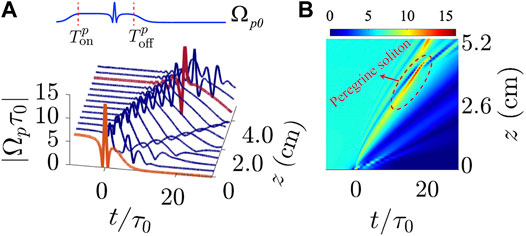
FIGURE 2. Propagation of ultraslow weak-light Peregrine solitons. (A)
The lower part of Figure 2A illustrates the result of a numerical simulation on the propagation of the Peregrine soliton (with
3 Storage, Retrieval, Splitting, and Routing of the Optical Peregrine Solitons
We now turn to consider the memory of the optical Peregrine solitons and related applications in optical splitting and routing through the manipulation of the control fields.
3.1 Storage and Retrieval of the Optical Peregrine Solitons
We first consider the storage and retrieval of optical Peregrine solitons obtained above, which can be implemented by switching off and on the control field described by the following switching function:
where
As an example, we take
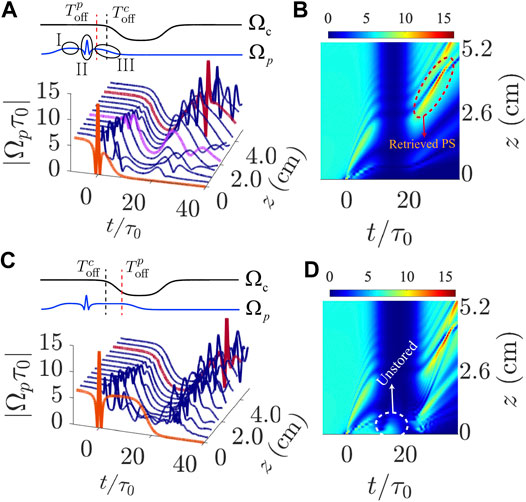
FIGURE 3. Storage and retrieval of optical Peregrine solitons. (A) Upper part: the black line (blue line) is the time sequence of the control (probe) field, the red dashed vertical line is
The steps of the storage and retrieval of the Peregrine soliton can be described as follows:
• Firstly, the control field
• Then, the control field is switched off at time
• Lastly, the control field is switched on again at
The efficiency of the Peregrine soliton memory can be characterized by the parameter
The fidelity of the Peregrine soliton memory can be described by the parameter
The numerical result shown in Figure 3C is similar to that of Figure 3A but for
3.2 Splitting of the Optical Peregrine Solitons
To realize an optical splitting [67] of the Peregrine soliton, we generalize the system into a four-level one with a tripod-type level configuration. Here a probe field
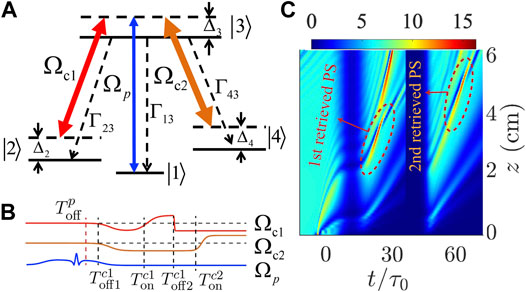
FIGURE 4. Splitting of optical Peregrine solitons. (A) Energy-level diagram and excitation scheme of the tripod-type four-level atomic system. Here, a probe laser field
The timing sequences of the switching-off and -on of
Shown in Figure 4C is the numerical result on the simulation for obtaining the Peregrine soliton splitter by taking
In the simulation, we have taken
3.3 Routing of the Optical Peregrine Solitons
To realize all-optical routing [67, 68] of optical Peregrine solitons, we consider a four-level atomic system with a double-
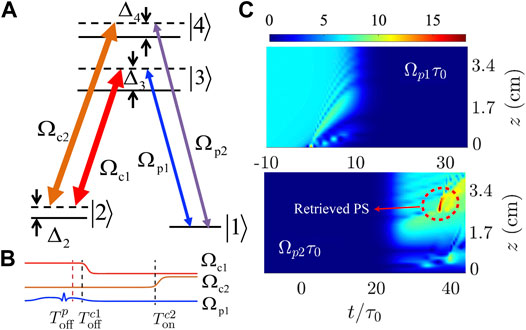
FIGURE 5. Routing of optical Peregrine solitons. (A) The energy-level diagram and excitation scheme of the double-
The Hamiltonian of the system and the MB equations governing the dynamics of the atoms and light fields have been given in Section 6 of the Supplementary Material.
For simplicity, here we consider a frequency routing process, i.e., the probe field
The implementing procedure of the Peregrine soliton routing is as follows. First, by switching on the control field
4 Conclusion
We have proposed a scheme for realizing the storage and retrieval of optical Peregrine solitons in a coherent atomic gas via EIT. We have shown that the optical Peregrine solitons with very small propagation loss, ultraslow motional velocity, and extremely low generation power can be generated in the system via EIT. We have demonstrated that such solitons can be stored, retrieved, split, and routed with high efficiency and fidelity through the manipulation of control laser fields.
The scheme can also be generalized to cases with more optical output channels through the use of more control fields, and hence the two-channel splitting and routing processes can be generalized to multiple channel ones. Furthermore, the storage and retrieval of the optical Peregrine solitons can be extended to solid materials, like on-chip optical resonator systems [69]. The research results reported here may be useful for the active control of optical Peregrine solitons and promising for potential applications in optical information processing and transmission.
Data Availability Statement
The raw data supporting the conclusion of this article will be made available by the authors, without undue reservation.
Author Contributions
GH proposed the idea and supervised the whole work. CS carried out the analytical and numerical calculation. Both authors contributed to the writing of the manuscript.
Funding
This work was supported by the National Natural Science Foundation of China under grant no. 11975098.
Conflict of Interest
The authors declare that the research was conducted in the absence of any commercial or financial relationships that could be construed as a potential conflict of interest.
Supplementary Material
The Supplementary Material for this article can be found online at: https://www.frontiersin.org/articles/10.3389/fphy.2021.594680/full#supplementary-material.
References
2. Akhmediev N, Ankiewicz A, Taki M. Waves that appear from nowhere and disappear without a trace. Phys Lett A (2009a) 373:675–8. doi:10.1016/j.physleta.2008.12.036
3. Stenflo L, Marklund M. Rogue waves in the atmosphere. J Plasma Phys (2010) 76:293–5. doi:10.1017/S0022377809990481
4. Efimov V, Ganshin A, Kolmakov G, McClintock P, Mezhov-Deglin L. Rogue waves in superfluid helium. Eur Phys J Spec Top (2010) 185:181–93. doi:10.1140/epjst/e2010-01248-5
5. Shats M, Punzmann H, Xia H. Capillary rogue waves. Phys Rev Lett (2010) 104:104503. doi:10.1103/PhysRevLett.104.104503
6. Chabchoub A, Hoffmann NP, Akhmediev N. Rogue wave observation in a water wave tank. Phys Rev Lett (2011) 106:204502. doi:10.1103/PhysRevLett.106.204502
7. Pierangeli D, Di Mei F, Conti C, Agranat AJ, DelRe E. Spatial rogue waves in photorefractive ferroelectrics. Phys Rev Lett (2015) 115:093901. doi:10.1103/PhysRevLett.115.093901
8. Moslem WM, Sabry R, El-Labany SK, Shukla PK. Dust-acoustic rogue waves in a nonextensive plasma. Phys Rev E (2011) 84:066402. doi:10.1103/PhysRevE.84.066402
9. Li BQ, Ma YL. Characteristics of rogue waves for a (2+1)-dimensional heisenberg ferromagnetic spin chain system. J Magn Magn Mater (2019) 474:537–43. doi:10.1016/j.jmmm.2018.10.133
10. Onorato M, Residori S, Bortolozzo U, Montina A, Arecchi F. Rogue waves and their generating mechanisms in different physical contexts. Phys Rep (2013) 528:47–89. doi:10.1016/j.physrep.2013.03.001
11. Dudley JM, Dias F, Erkintalo M, Genty G. Instabilities, breathers and rogue waves in optics. Nat Photon (2014) 8:755–64. doi:10.1038/nphoton.2014.220
12. Peregrine DH. Water waves, nonlinear schrödinger equations and their solutions. J Aust Math Soc Ser B (1983) 25:16–43. doi:10.1017/S0334270000003891
13. Akhmediev N, Soto-Crespo J, Ankiewicz A. Extreme waves that appear from nowhere: on the nature of rogue waves. Phys Lett A (2009b) 373:2137–45. doi:10.1016/j.physleta.2009.04.023
14. Shrira VI, Geogjaev VV. What makes the peregrine soliton so special as a prototype of freak waves? J Eng Math (2010) 67:11–22. doi:10.1007/s10665-009-9347-2
15. Ma YC. The perturbed plane-wave solutions of the cubic schrödinger equation. Stud Appl Math (1979) 60:43–58. doi:10.1002/sapm197960143
16. Akhmediev NN, Eleonskii VM, Kulagin NE. Exact first-order solutions of the nonlinear schrödinger equation. Theor Math Phys (1987) 72:809–18. doi:10.1007/BF01017105
17. Bailung H, Sharma SK, Nakamura Y. Observation of peregrine solitons in a multicomponent plasma with negative ions. Phys Rev Lett (2011) 107:255005. doi:10.1103/PhysRevLett.107.255005
18. Chabchoub A, Neumann S, Hoffmann NP, Akhmediev N. Spectral properties of the eregrine soliton observed in a water wave tank. J Geophys Res (2012) 117:C00J03. doi:10.1029/2011JC007671
19. Shemer L, Alperovich L. Peregrine breather revisited. Phys Fluids (2013) 25:051701. doi:10.1063/1.4807055
20. Sharma SK, Bailung H. Observation of hole peregrine soliton in a multicomponent plasma with critical density of negative ions. J Geophys Res Space Phys (2013) 118:919–24. doi:10.1002/jgra.50111
21. Al Khawaja U, Bahlouli H, Asad-uz-zaman M, Al-Marzoug S. Modulational instability analysis of the peregrine soliton. Commun Nonlinear Sci Numer Simulat (2014) 19:2706–14. doi:10.1016/j.cnsns.2014.01.002
22. Chen S, Song LY. Peregrine solitons and algebraic soliton pairs in Kerr media considering space-time correction. Phys Lett A (2014) 378:1228–32. doi:10.1016/j.physleta.2014.02.042
23. Dai CQ, Wang YY. Controllable combined peregrine soliton and Kuznetsov-Ma soliton in -symmetric nonlinear couplers with gain and loss. Nonlinear Dyn (2015) 91:715–21. doi:10.1007/s11071-015-1900-0
24. Gupta SK, Sarma AK. Peregrine rogue wave dynamics in the continuous nonlinear schrödinger system with parity-time symmetric Kerr nonlinearity. Commun. Nonlinear Sci Numer Simulat (2016) 36:141–7. doi:10.1016/j.cnsns.2015.11.017
25. Solli DR, Ropers C, Koonath P, Jalali B. Optical rogue waves. Nature (2007) 450:1054–7. doi:10.1038/nature06402
26. Solli DR, Ropers C, Jalali B. Active control of rogue waves for stimulated supercontinuum generation. Phys Rev Lett (2008) 101:233902. doi:10.1103/PhysRevLett.101.233902
27. Montina A, Bortolozzo U, Residori S, Arecchi FT. Non-Gaussian statistics and extreme waves in a nonlinear optical cavity. Phys Rev Lett (2009) 103:173901. doi:10.1103/PhysRevLett.103.173901
28. Kibler B, Fatome J, Finot C, Millot G, Dias F, Genty G, et al. The Peregrine soliton in nonlinear fibre optics. Nat Phys (2010) 6:790–5. doi:10.1038/NPHYS1740
29. Bonatto C, Feyereisen M, Barland S, Giudici M, Masoller C, Leite JRR, et al. Deterministic optical rogue waves. Phys Rev Lett (2011) 107:053901. doi:10.1103/PhysRevLett.107.053901
30. Hammani K, Kibler B, Finot C, Morin P, Fatome J, Dudley JM, et al. Peregrine soliton generation and breakup in standard telecommunications fiber. Opt Lett (2011) 36:112–4. doi:10.1364/OL.36.000112
31. Zaviyalov A, Egorov O, Iliew R, Lederer F. Rogue waves in mode-locked fiber lasers. Phys Rev A (2012) 85:013828. doi:10.1103/PhysRevA.85.013828
32. Akhmediev N, Dudley JM, Solli DR, Turitsyn SK. Recent progress in investigating optical rogue waves. J Opt (2013) 15:060201. doi:10.1088/2040-8978/15/6/060201
33. Bludov YV, Driben R, Konotop VV, Malomed BA. Instabilities, solitons and rogue waves in -coupled nonlinear waveguides. J Opt (2013) 15:064010. doi:10.1088/2040-8978/15/6/064010
34. Zhang Y, Belić MR, Zheng H, Chen H, Li C, Song J, et al. Nonlinear talbot effect of rogue waves. Phys Rev E (2014) 89:032902. doi:10.1103/PhysRevE.89.032902
35. Yang G, Wang Y, Qin Z, Malomed BA, Mihalache D, Li L. Breatherlike solitons extracted from the peregrine rogue wave. Phys Rev E (2014) 90:062909. doi:10.1103/PhysRevE.90.062909
36. Suret P, Koussaifi RE, Tikan A, Evain C, Randoux S, Szwaj C, et al. Single-shot observation of optical rogue waves in integrable turbulence using time microscopy. Nat Commun (2016) 7:13136. doi:10.1038/ncomms13136
37. Tikan A, Billet C, El G, Tovbis A, Bertola M, Sylvestre T, et al. Universality of the peregrine soliton in the focusing dynamics of the cubic nonlinear schrödinger equation. Phys Rev Lett (2017) 119:033901. doi:10.1103/PhysRevLett.119.033901
38. Randoux S, Suret P, Chabchoub A, Kibler B, El G. Nonlinear spectral analysis of peregrine solitons observed in optics and in hydrodynamic experiments. Phys Rev E (2018) 98:022219. doi:10.1103/PhysRevE.98.022219
39. Xu G, Hammani K, Chabchoub A, Dudley JM, Kibler B, Finot C. Phase evolution of peregrine-like breathers in optics and hydrodynamics. Phys Rev E (2019a) 99:012207. doi:10.1103/PhysRevE.99.012207
40. Yang G, Li L, Jia S. Peregrine rogue waves induced by the interaction between a continuous wave and a soliton. Phys Rev E. (2012) 85:046608. doi:10.1103/PhysRevE.85.046608
41. Tiofack CGL, Coulibaly S, Taki M, De Bièvre S, Dujardin G. Comb generation using multiple compression points of Peregrine rogue waves in periodically modulated nonlinear Schrödinger equations. Phys Rev A (2015) 92:043837. doi:10.1103/PhysRevA.92.043837
42. Li J, Han J, Du Y, Dai C. Controllable behaviors of Peregrine soliton with two peaks in a birefringent fiber with higher-order effects. Nonlinear Dyn (2015) 82:1393–8. doi:10.1007/s11071-015-2246-3
43. Chowdury A, Kedziora DJ, Ankiewicz A, Akhmediev N. Breather-to-soliton conversions described by the quintic equation of the nonlinear Schrödinger hierarchy. Phys Rev E (2015) 91:032928. doi:10.1103/PhysRevE.91.032928
44. Chen S, Baronio F, Soto-Crespo JM, Liu Y, Grelu P. Chirped Peregrine solitons in a class of cubic-quintic nonlinear Schrödinger equations. Phys Rev E (2016) 93:062202. doi:10.1103/PhysRevE.93.062202
45. Wang L, Zhang JH, Liu C, Li M, Qi FH. Breather transition dynamics, peregrine combs and walls, and modulation instability in a variable-coefficient nonlinear Schrödinger equation with higher-order effects. Phys Rev E (2016) 93:062217. doi:10.1103/PhysRevE.93.062217
46. Dai CQ, Liu J, Fan Y, Yu DG. Two-dimensional localized Peregrine solution and breather excited in a variable-coefficient nonlinear Schrödinger equation with partial nonlocality. Nonlinear Dyn (2017) 88:1373–83. doi:10.1007/s11071-016-3316-x
47. Özkan YS, Yaşar E, Seadawy AR. On the multi-waves, interaction and Peregrine-like rational solutions of perturbed Radhakrishnan–Kundu–Lakshmanan equation. Phys Scr (2020) 95:085205. doi:10.1088/1402-4896/ab9af4
48. Chen S. Twisted rogue-wave pairs in the Sasa-Satsuma equation. Phys Rev E (2013) 88:023202. doi:10.1103/PhysRevE.88.023202
49. Chen S, Grelu P, Soto-Crespo JM. Dark- and bright-rogue-wave solutions for media with long-wave–short-wave resonance. Phys Rev E (2014a) 89:011201. doi:10.1103/PhysRevE.89.011201
50. Chen S, Ye Y, Soto-Crespo JM, Grelu P, Baronio F. Peregrine solitons beyond the threefold limit and their two-soliton interactions. Phys Rev Lett (2018) 121:104101. doi:10.1103/PhysRevLett.121.104101
51. Chen S, Pan C, Grelu P, Baronio F, Akhmediev N. Fundamental peregrine solitons of ultrastrong amplitude enhancement through self-steepening in vector nonlinear systems. Phys Rev Lett (2020) 124:113901. doi:10.1103/PhysRevLett.124.113901
52. Xu G, Gelash A, Chabchoub A, Zakharov V, Kibler B. Breather wave molecules. Phys Rev Lett (2019b) 122:084101. doi:10.1103/PhysRevLett.122.084101
53. Asgarnezhad-Zorgabad S, Berini P, Sanders BC. Polaritonic frequency-comb generation and breather propagation in a negative-index metamaterial with a cold four-level atomic medium. Phys Rev A (2019) 99:051802. doi:10.1103/PhysRevA.99.051802
54. Asgarnezhad-Zorgabad S, Sadighi-Bonabi R, Kibler B, Özdemir ŞK, Sanders BC. Surface-polaritonic phase singularities and multimode polaritonic frequency combs via dark rogue-wave excitation in hybrid plasmonic waveguide. New J Phys (2020) 22:033008. doi:10.1088/1367-2630/ab7259
55. Fleischhauer M, Imamoglu A, Marangos JP. Electromagnetically induced transparency: optics in coherent media. Rev Mod Phys (2005) 77:633–73. doi:10.1103/RevModPhys.77.633
56. Huang G, Deng L, Payne MG. Dynamics of ultraslow optical solitons in a cold three-state atomic system. Phys Rev E (2005) 72:016617. doi:10.1103/PhysRevE.72.016617
57. Chen Y, Bai Z, Huang G. Ultraslow optical solitons and their storage and retrieval in an ultracold ladder-type atomic system. Phys Rev A (2014b) 89:023835. doi:10.1103/PhysRevA.89.023835
58. Xu D, Chen Z, Huang G. Ultraslow weak-light solitons and their storage and retrieval in a kagome-structured hollow-core photonic crystal fiber. Opt Express (2017) 25:19094–111. doi:10.1364/OE.25.019094
59. Liu J, Hang C, Huang G. Weak-light rogue waves, breathers, and their active control in a cold atomic gas via electromagnetically induced transparency. Phys Rev A (2016) 93:063836. doi:10.1103/PhysRevA.93.063836
60. Liu J, Hang C, Huang G. Weak-light vector rogue waves, breathers, and their Stern-Gerlach deflection via electromagnetically induced transparency. Opt Express (2017) 25:23408–23. doi:10.1364/OE.25.023408
62. Steck DA. Rubidium 87 D line data (2019) https://steck.us/alkalidata/ (Accessed August 3, 2020).
64. Kivshar YS, Luther-Davies B. Dark optical solitons: physics and applications. Phys Rep (1998) 298:81–197. doi:10.1016/S0370-1573(97)00073-2
65. Shou C, Huang G. Storage and retrieval of slow-light dark solitons. Opt Lett (2020) 45:6787–90. doi:10.1364/OL.412247
66. Mazets IE. Adiabatic pulse propagation in coherent atomic media with the tripod level configuration. Phys Rev A (2005) 71:023806. doi:10.1103/PhysRevA.71.023806
67. Shou C, Huang G. Slow-light soliton beam splitters. Phys Rev A (2019) 99:043821. doi:10.1103/PhysRevA.99.043821
68. Lemr K, Bartkiewicz K, Černoch A, Soubusta J. Resource-efficient linear-optical quantum router. Phys Rev A (2013) 87:062333. doi:10.1103/PhysRevA.87.062333
Keywords: electromagnetically induced transparency, rogue waves, Peregrine solitons, optical memory, optical routing
Citation: Shou C and Huang G (2021) Storage, Splitting, and Routing of Optical Peregrine Solitons in a Coherent Atomic System. Front. Phys. 9:594680. doi: 10.3389/fphy.2021.594680
Received: 14 August 2020; Accepted: 18 January 2021;
Published: 24 March 2021.
Edited by:
Amin Chabchoub, The University of Sydney, AustraliaReviewed by:
Saeid Asgarnezhad Zorgabad, Sharif University of Technology, IranStefano Trillo, University of Ferrara, Italy
Copyright © 2021 Shou and Huang. This is an open-access article distributed under the terms of the Creative Commons Attribution License (CC BY). The use, distribution or reproduction in other forums is permitted, provided the original author(s) and the copyright owner(s) are credited and that the original publication in this journal is cited, in accordance with accepted academic practice. No use, distribution or reproduction is permitted which does not comply with these terms.
*Correspondence: Guoxiang Huang, Z3hodWFuZ0BwaHkuZWNudS5lZHUuY24=
 Chong Shou1
Chong Shou1 Guoxiang Huang
Guoxiang Huang